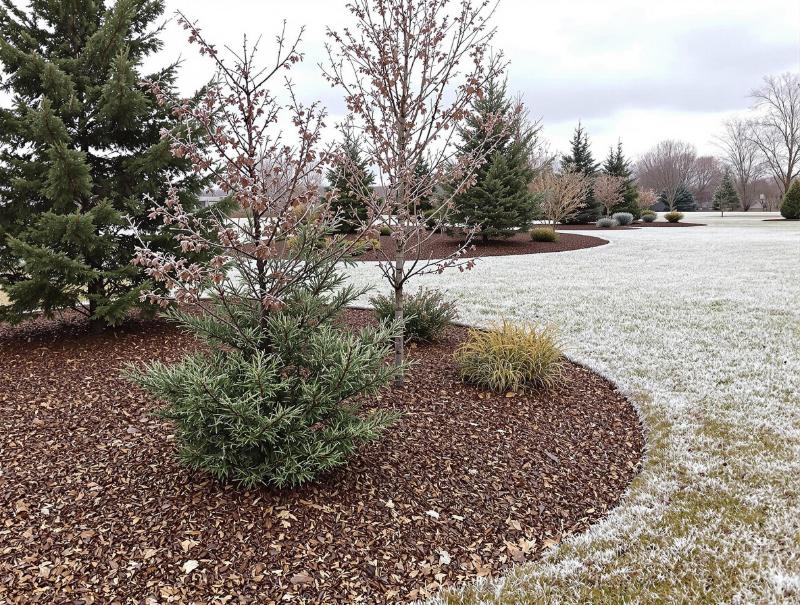Simple Ways to Make Gardens Thrive Through Winter

Winter can be challenging for British gardens, with frost, rain and harsh conditions often leaving outdoor spaces looking tired and neglected. Yet with a few simple tricks, your garden can stay healthy and vibrant throughout the colder months.
Bark mulch serves as a protective blanket for your garden soil, helping to regulate temperature and prevent frost damage to delicate root systems. This insulating layer keeps soil warmer during freezing spells and reduces the impact of heavy rainfall that can lead to soil erosion or waterlogging. As it gradually breaks down, bark mulch also enriches your soil with nutrients that will support stronger plant growth when spring arrives.
Applying a fresh layer of bark mulch before winter sets in also reduces maintenance needs. The thick covering suppresses weeds that might otherwise take hold during milder winter periods, meaning less work for you when gardening season returns.
The Royal Horticultural Society points out that while cold can slow soil biological activity, mulching helps moderate soil temperature and supports the living ecosystem that keeps plants healthy.
UK winter months regularly experience persistent rainfall, which can quickly wash away nutrient-rich topsoil when gardens lack protection. Winter winds compound the problem by drying out evergreen plants when their roots can’t replace lost moisture from frozen ground.
Prevention supports gardens through these tough months. While some gardeners use plastic coverings or fabric sheets, these often look unsightly and can trap excess moisture. A thick layer of organic material, like bark mulch, provides shelter while improving soil structure. It acts as a barrier against harsh winter elements while gradually feeding the soil beneath.
Benefits of Bark Mulch During Cold Months
Bark mulch forms a thick, natural insulation over winter soil, reducing temperature swings and helping stop frost from reaching plant roots. Applying mulch after the first frost is effective for this protection.
This material also absorbs rainfall and slowly releases moisture. That steadiness helps maintain consistent soil dampness, lowering the risk of both drought stress and waterlogged beds during periods of heavy rain. It means less frequent watering and healthier roots during unpredictable weather.
Weed suppression continues all winter. Many common weeds can germinate during occasional mild spells, but a recommended 5cm of mulch keeps light from reaching their seeds, so gardeners see far fewer weeds come spring.
As bark mulch breaks down, it adds humus and nutrients, gradually improving the soil’s texture and water retention. The breakdown happens even during winter, setting up beds for stronger spring growth.
Bark mulch’s rich brown adds neat contrast against evergreen foliage, keeping gardens tidy and visually appealing through bare winter months.
Which Plants Benefit Most From Winter Mulching
Newly planted trees and shrubs need winter mulch because their roots haven’t yet reached deep soil layers that stay insulated. Applying a ring of bark mulch—30 to 45cm from the trunk—creates a buffer against rapid soil cooling. Always leave a gap between mulch and bark to avoid moisture collecting at the base, which can cause disease. If mulch sits against the trunk, it increases the risk of rot, especially during damp winter spells.
Shallow-rooted perennials like hostas, astilbes, and heucheras depend on surface protection. These plants sit close to soil level, so a 7–10cm mulch layer helps prevent frost heave, which can push roots out of the ground after freezing nights. Consistent mulch depth stops soil from warming and cooling too quickly, reducing stress on roots during the worst winter temperature swings.
Pine bark mulch stands out for acid-loving plants, including rhododendrons, azaleas, camellias, and blueberries. As it breaks down, it keeps the pH around the roots on the acidic side. This slow release supports healthy foliage while also guarding roots from winter chill. Applying the right product brings both chemical balance and cold protection in one step.
Container plants lose heat quickly since their roots aren’t protected by the surrounding earth. Adding bark mulch to finish your planting beds and using a 5cm topping in pots helps insulate roots. Wrapping containers in hessian before mulching reduces freeze damage, which is key for potted perennials and small evergreens left outdoors.
Choosing the Right Bark Mulch for Winter Protection
Pine bark delivers reliable winter insulation and promotes garden health through its slow, even decomposition. The naturally acidic pH suits popular acid-loving plants and helps maintain balanced soil levels. Gardeners will appreciate that pine bark lasts 7–9 months, so it rarely needs midwinter replacement. For maximum effectiveness, always install after the first frost with a 5–7cm layer. Since its light weight can allow wind displacement, consider using a mesh or border in exposed patches.
Cedar bark stands out where pest resistance is as important as frost protection. Its aromatic oils act as a lasting deterrent against overwintering insects and slugs, which lessens early spring pest problems. Cedar maintains its structure for up to 12 months and offers consistent colour, improving winter aesthetics as well as function. This durability reduces annual upkeep for many gardeners.
Mixed bark mulches offer short-term value and broad-spectrum protection, balancing cost with seasonal coverage. Because these blends contain varying particle sizes and wood types, confirm with your supplier how long the product will last before reapplication is required. Always match the mix to your garden’s exposure and maintenance goals for best results.
Particle size modifies the mulch’s effect: fine grades (10–20mm) give rapid nutrient availability but break down quickly, medium grades (20–40mm) offer a neat look plus steady warmth, and coarse types (40–60mm) provide maximum insulation but can appear rougher. Choose a medium grade to combine neatness and prolonged root protection through the frosty months.
Sourcing bark mulch with FSC certification supports environmental responsibility. Selecting local suppliers not only reduces carbon footprint but can support the regional economy, making this both a practical and eco-conscious winter garden choice.
Proper Application Techniques for Maximum Benefit
Timing matters when applying winter mulch, as the soil needs to be cool but not frozen. For most UK gardens, mid to late November is best, after the first light frosts signal plant dormancy. Early mulching can retain too much warmth, risking poor winter hardiness, while waiting until the soil freezes limits insulation and leaves plants exposed to frost damage. Check the soil with a gloved hand; it should be firm and chilly but not solid.
Correct depth is essential for protection. Apply a consistent 5–7cm layer for trees and established beds, and ensure at least 5cm for flower borders. Thin layers provide little insulation, but excess over 10cm can suffocate roots or shelter pests. Use a rake to create an even cover, which helps moisture reach roots and maintains air flow.
For trees, form a ring with mulch extending 30–60cm from the trunk, and always leave a 5–8cm gap at the base. This prevents bark rot and lets water flow to roots—a mistake called “volcano mulching” traps moisture, attracting disease and pests. Carefully inspect for gaps after storms, as wind can shift mulch away from trunks.
Avoid piling mulch against stems, too much thickness, and skipping debris removal before spreading. Always clear weeds and fallen leaves first to reduce pest risk. A wheelbarrow, garden fork, and rake make application efficient, while gloves and a kneeler keep the process comfortable. For large gardens, a mulch spreader saves significant time.
Winter Mulching for Small Urban Gardens
London’s small gardens and patios demand precise mulching to shield root zones exposed to winter cold, making every square metre work harder. Applying bark mulch around the bases of shrubs, within raised beds, and in container pockets ensures roots are insulated where frost risk is highest. Avoid spreading mulch on walkways or hardscape since this wastes material and impedes access—focus only on vulnerable planted areas for targeted results.
Maintain a mulch layer of 5-7cm, which research confirms is deep enough to reduce temperature swings and help soil retain moisture without suffocating roots. In containers, add mulch after watering, which locks moisture beneath the mulch and stabilises temperatures for potted plants that lose heat quickly near exposed paving.
For communal gardens, finely graded bark gives consistent cover and is easier to sweep into place. Never block drainage with mulch or let it touch building edges; always keep a slight gap so water drains freely and walls stay dry.
Refresh the mulch layer after clearing leaves in autumn so decomposed material doesn’t compromise winter protection. Add bark mulch to finish your planting beds and to insulate raised containers, helping urban plants survive unpredictable winter weather while improving visual appeal through colder months.





